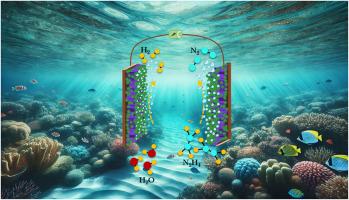Hierarchical micro-nano 3D structures of metal selenides on 2D NiCo–MXene nanosheets as a dual-layer electrocatalyst for effective seawater electrolysis and hydrazine degradation
IF 9.7
2区 材料科学
Q1 MATERIALS SCIENCE, MULTIDISCIPLINARY
引用次数: 0
Abstract
Seawater as an abundant and low-cost feedstock electrolyte is an outstanding candidate for electrolysis of water and producing significant gases such as hydrogen and oxygen during hydrogen evolution reaction (HER) and oxygen evolution reaction (OER), respectively. Seawater has a complex mixture including various ions and contaminations (e.g., hydrazine in the vicinity of industrial zones) that can interfere with a water electrolysis process. Thus, designing an effective electrocatalyst to facilitate seawater electrolysis and also transforming the hydrazine-damaging contamination into safer substances during the hydrazine oxidation reaction (HzOR) is a key factor. Herein, a two-layer electrocatalyst consisting of Viburnum flower-like three-phase 3D metal selenide structures decorated on the surface of the 2D NiCo–MXene (MS@NCT) nanocomposite is prepared using a fast two-step electrochemical procedure, which delivers remarkable trifunctional electrocatalytic activity for HER, OER, and HzOR reactions. The well-designed architecture of the MS@NCT electrocatalyst catalyzes the HER and OER processes at low overpotentials of 52 and 170 mV at a rate of −10 and 10 mA cm−2 in alkaline electrolyte (1.0 M KOH), respectively. This nanocomposite as cathode and anode electrodes demands only a cell voltage of 1.47 V to afford a current density of 10 mA cm−2 in the same electrolyte during overall water splitting (OWS). The investigation of the electrocatalytic activity of prepared electrocatalyst in alkaline seawater demonstrates the close overpotential for HER (52 mV at current density of −10 mA cm−2), OER (190 mV at current density of 10 mA cm−2), and OWS cell voltage (1.48 V at current density of 10 mA cm−2) compared to 1.0 M KOH. The hydrazine-assisted hydrogen production ability of MS@NCT with low voltage of 87 mV at low current density of 10 mA cm−2 and 266 mV at high current density of 100 mA cm−2 in alkaline seawater containing 0.5 M hydrazine proves the excellent efficiency of hierarchical multiphase electrocatalyst. DFT studies reveal FeSe@NiCo–MXene (FeSe@NCT) as a synergistic electrocatalyst, where interfacial charge redistribution and d-band modulation enhance conductivity and balance adsorption-desorption energetics. MXene weakens H∗ binding on NiCo and FeSe besides optimizing N2 release, boosting HER and HzOR efficiency. They underscore interfacial electronic engineering for designing multifunctional catalysts.


金属硒化物在二维NiCo-MXene纳米片上的分层微纳三维结构作为海水电解和肼降解的双层电催化剂
海水作为一种储量丰富且成本低廉的原料电解质,在析氢反应(HER)和析氧反应(OER)中分别是电解水和产生氢气和氧气等重要气体的理想选择。海水是一种复杂的混合物,包括各种离子和污染物(例如,工业区附近的联氨),这些污染物会干扰水电解过程。因此,设计一种有效的电催化剂来促进海水电解,并在肼氧化反应(HzOR)中将有害肼的污染物转化为更安全的物质是关键因素。本文采用快速的两步电化学方法,在二维NiCo-MXene (MS@NCT)纳米复合材料表面修饰了Viburnum花状三相三维金属硒化物结构,制备了两层电催化剂,该电催化剂对HER、OER和HzOR反应具有显著的三功能电催化活性。设计良好的MS@NCT电催化剂结构在碱性电解质(1.0 M KOH)中分别以- 10和10 mA cm-2的速率在52和170 mV的低过电位下催化HER和OER过程。这种纳米复合材料作为阴极和阳极电极只需要1.47 V的电池电压,就可以在相同的电解质中提供10 mA cm-2的电流密度。制备的电催化剂在碱性海水中的电催化活性研究表明,与1.0 M KOH相比,HER(在- 10 mA cm-2电流密度下为52 mV)、OER(在10 mA cm-2电流密度下为190 mV)和OWS电池电压(在10 mA cm-2电流密度下为1.48 V)的过电位接近。在含0.5 M联氨的碱性海水中,MS@NCT在低电流密度为10 mA cm−2、高电流密度为100 mA cm−2时的低电压为87 mV和高电流密度为266 mV的联氨辅助制氢能力证明了分级多相电催化剂的优异效率。DFT研究表明FeSe@NiCo -MXene (FeSe@NCT)是一种协同电催化剂,其中界面电荷重新分配和d波段调制增强了电导率并平衡了吸附-脱附能量。MXene在优化N2释放的同时,减弱了NiCo和FeSe上的H*结合,提高了HER和HzOR效率。他们强调界面电子工程设计多功能催化剂。
本文章由计算机程序翻译,如有差异,请以英文原文为准。
求助全文
约1分钟内获得全文
求助全文
来源期刊

Materials Today Physics
Materials Science-General Materials Science
CiteScore
14.00
自引率
7.80%
发文量
284
审稿时长
15 days
期刊介绍:
Materials Today Physics is a multi-disciplinary journal focused on the physics of materials, encompassing both the physical properties and materials synthesis. Operating at the interface of physics and materials science, this journal covers one of the largest and most dynamic fields within physical science. The forefront research in materials physics is driving advancements in new materials, uncovering new physics, and fostering novel applications at an unprecedented pace.
 求助内容:
求助内容: 应助结果提醒方式:
应助结果提醒方式:


